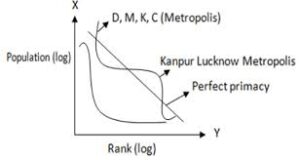The concepts of Primate City and Rank Size Rule are both related to the distribution of population and urban settlements. The Primate city refers to the phenomenon where one large city dominates a country’s urban hierarchy, both in terms of population and economic activity. The Rank-Size Rule, on the other hand, suggests that the population of a city is inversely proportional to its rank in the urban hierarchy.

Table of Contents
Primate City
A Primate city is a city that is significantly larger than all other cities in a country. It often serves as the economic, cultural, and political center of the country, dominating the urban hierarchy. In many cases, the Primate city may be several times larger than the next largest city in the country. Examples of Primate cities include Paris in France, Mexico City in Mexico, and Bangkok in Thailand.
The phenomenon of the Primate city can have both positive and negative impacts. On the positive side, a Primate city can serve as a hub for economic development, innovation, and cultural exchange. On the negative side, a Primate city can lead to regional disparities, as resources and investment are concentrated in one area, leading to neglect of other regions.
Rank-Size Rule
The Rank-Size Rule, formulated by G. K. Zipf, is an empirical observation about the relationship between the rank and size of cities or urban areas within a country or region. It states that the population of a city is inversely proportional to its rank in the urban hierarchy. In other words, the second-largest city is typically half the size of the largest city, the third-largest city is one-third the size of the largest city, and so on.
The Rank-Size Rule can be expressed mathematically as follows:
P = a / R
Where:
- P represents the population of a city,
- R represents the rank of the city in the urban hierarchy, and
- ‘a’ is a constant that may vary depending on the specific context.
According to Zipf’s observation, when cities are ranked in descending order of population, the relationship between population and rank follows a power-law distribution. This means that the population of a city is approximately proportional to the inverse of its rank raised to some exponent.
Zipf’s Rank-Size Rule has been found to hold true in many countries and regions, although with some variations and deviations. It is often observed that the largest city in a country has a disproportionately larger population compared to the smaller cities. However, as the rank decreases, the difference in population between cities becomes less pronounced.
The Rank-Size Rule has important implications for urban planning, regional development, and economic analysis. It suggests that larger cities tend to have a greater concentration of economic activities, infrastructure, and services, making them attractive centers of commerce, culture, and innovation. However, the rule also highlights the potential challenges of urbanization, such as overcrowding, inadequate infrastructure, and disparities in resource distribution between larger and smaller cities.
While the Rank-Size Rule provides a useful framework for understanding urban hierarchies, it is important to note that it is an empirical observation and does not account for all factors that influence urban growth and population distribution. Factors such as historical, cultural, political, and geographical factors can also play a significant role in shaping the size and distribution of cities within a region.
Thanks for reading article on Primate City and Rank Size Rule.